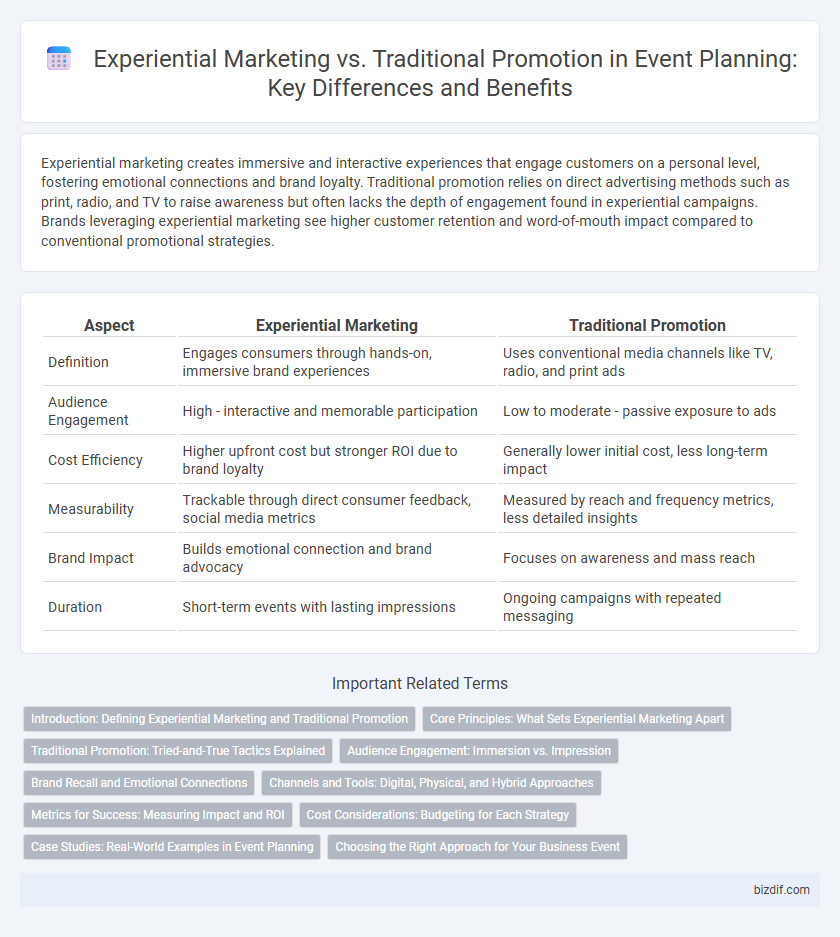Experiential marketing creates immersive and interactive experiences that engage customers on a personal level, fostering emotional connections and brand loyalty. Traditional promotion relies on direct advertising methods such as print, radio, and TV to raise awareness but often lacks the depth of engagement found in experiential campaigns. Brands leveraging experiential marketing see higher customer retention and word-of-mouth impact compared to conventional promotional strategies.
Table of Comparison
| Aspect | Experiential Marketing | Traditional Promotion |
|---|---|---|
| Definition | Engages consumers through hands-on, immersive brand experiences | Uses conventional media channels like TV, radio, and print ads |
| Audience Engagement | High - interactive and memorable participation | Low to moderate - passive exposure to ads |
| Cost Efficiency | Higher upfront cost but stronger ROI due to brand loyalty | Generally lower initial cost, less long-term impact |
| Measurability | Trackable through direct consumer feedback, social media metrics | Measured by reach and frequency metrics, less detailed insights |
| Brand Impact | Builds emotional connection and brand advocacy | Focuses on awareness and mass reach |
| Duration | Short-term events with lasting impressions | Ongoing campaigns with repeated messaging |
Introduction: Defining Experiential Marketing and Traditional Promotion
Experiential marketing immerses consumers in interactive brand experiences, fostering emotional connections and memorable engagement. Traditional promotion relies on conventional channels such as print, TV, and radio ads to deliver straightforward brand messages. Understanding these approaches highlights the shift towards experiential methods that prioritize customer involvement over passive exposure.
Core Principles: What Sets Experiential Marketing Apart
Experiential marketing centers on immersive brand engagement, creating memorable sensory experiences that foster emotional connections, whereas traditional promotion relies on one-way communication through ads and discounts. This approach leverages interactive activities, live events, and personal interactions to build brand loyalty and drive word-of-mouth. Unlike conventional methods, experiential marketing prioritizes consumer participation and authentic storytelling, generating deeper brand resonance.
Traditional Promotion: Tried-and-True Tactics Explained
Traditional promotion relies on established tactics such as print advertising, direct mail, television commercials, and radio spots to reach broad audiences effectively. These methods provide measurable results through trackable metrics like reach, frequency, and conversion rates, making them reliable for consistent brand messaging. Businesses often choose traditional promotion for its ability to build long-term brand recognition and trust through repetitive exposure in familiar media channels.
Audience Engagement: Immersion vs. Impression
Experiential marketing drives deeper audience engagement by creating immersive, interactive experiences that foster emotional connections and brand loyalty. Traditional promotion primarily relies on delivering impressions through passive exposure, such as advertisements or flyers, which often results in lower retention and limited consumer interaction. Immersion in experiential campaigns enhances memorable brand experiences, increasing the likelihood of positive word-of-mouth and long-term customer relationships.
Brand Recall and Emotional Connections
Experiential marketing significantly enhances brand recall by engaging consumers through interactive and immersive experiences that create lasting emotional connections. Unlike traditional promotion, which often relies on passive exposure like ads or flyers, experiential campaigns foster genuine consumer involvement, leading to stronger memory retention and positive brand associations. Emotional engagement in experiential marketing drives deeper loyalty and can increase conversion rates by making the brand experience personally meaningful.
Channels and Tools: Digital, Physical, and Hybrid Approaches
Experiential marketing leverages immersive digital platforms, interactive physical events, and hybrid setups to create memorable, engaging brand experiences that foster deeper customer connections. Traditional promotion primarily relies on physical channels such as print media, billboards, and in-person advertising, with limited integration of digital tools. Hybrid approaches combine the reach of digital marketing--social media, email campaigns, and virtual reality--with tangible experiences like live events and product demonstrations to maximize audience engagement and measurement.
Metrics for Success: Measuring Impact and ROI
Experiential marketing outperforms traditional promotion by delivering higher engagement rates, with metrics such as dwell time, social shares, and direct consumer interactions driving measurable brand loyalty. Traditional promotion relies on reach and frequency measurements, primarily tracking impressions, click-through rates, and conversion rates for ROI analysis. Analyzing customer sentiment and real-time feedback in experiential campaigns provides deeper insights into emotional impact, complementing quantitative sales data for a comprehensive assessment of marketing effectiveness.
Cost Considerations: Budgeting for Each Strategy
Experiential marketing often requires a higher initial investment due to immersive event production, technology integration, and personalized engagement elements, but it can yield stronger brand recall and customer loyalty. Traditional promotion typically involves lower upfront costs through mass media channels like print, radio, and digital ads, offering broader reach with less direct customer interaction. Careful budgeting must weigh the cost-effectiveness of experiential events' impactful brand experiences against traditional promotion's scalable, cost-efficient advertising methods.
Case Studies: Real-World Examples in Event Planning
Case studies in event planning highlight experiential marketing's impact by showcasing immersive brand activations that increase attendee engagement and recall, such as Red Bull's interactive sports events drawing millions globally. In contrast, traditional promotion often relies on standard advertising and sponsorship, demonstrated by Coca-Cola's widespread use of billboards and TV spots during major events with measurable but less interactive audience reach. Analysis reveals experiential campaigns typically yield higher social media interaction and direct customer feedback, crucial metrics for evolving event strategies in competitive markets.
Choosing the Right Approach for Your Business Event
Experiential marketing creates immersive, interactive experiences that deepen audience engagement and brand loyalty, making it ideal for brands seeking emotional connections and memorable impact. Traditional promotion relies on broad reach through channels like print, TV, and digital ads, offering greater control over messaging and longer-term audience exposure. Selecting the right approach depends on event objectives, target audience preferences, and budget allocation to maximize ROI and brand visibility.
Experiential marketing vs Traditional promotion Infographic

 bizdif.com
bizdif.com